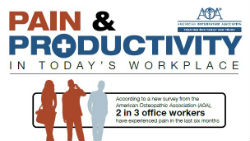
New research released today by the American Osteopathic Association (AOA) reveals that the majority of Americans who work in an office are experiencing physical pain with some frequency.
The new survey indicates two in three office workers have experienced physical pain in the last six months, and nearly one in four believe it’s just a standard part of having an office job.
According to the AOA, this misconception can lead office workers to ignore or under-treat their pain, creating a debilitating cycle that results in chronic or reoccurring pain. Chronic pain is a serious public health issue reportedly affecting 100 million Americans today and impacting more people than cancer, diabetes, and heart disease combined.
To address the issue, the AOA is launching a new phase of the “Break Through Your Pain” public education campaign to help office workers be productive and pain-free with tips, tools and advice they need to prevent and relieve pain.
The AOA says the office environment offers numerous opportunities to trigger physical pain, including the five-plus hours that 70 percent of office workers spend sitting at their desks each day. Some habits that can boost chances of pain include hunching over a desk, sitting in an uncomfortable chair, staring a computer monitor, and using a computer mouse.
Consider the following tips when sitting at your desk to prevent pain and become more active throughout the workday.
Get Up and Get Moving
- Listen to Mom, Don’t Slouch: Sit up straight and don’t hunch over your computer to engage your abdominal muscles and reduce strain on your back.
- Keep Feet Flat on the Floor: Put both feet flat on the floor and the rest of your body will respond and improve your posture.
- Keep Those Eyes Straight Ahead: Place your computer monitor to where the top of the screen is at eye level to reduce strain on your neck muscles.
- Avoid the Mouse Trap: As you type and move your mouse, make sure your elbows stay close to your body and your wrists are not bending too far forwards or backwards.
- Get Up, Stand Up: Set an alert on your calendar or phone for every 30 minutes to remind yourself to take a stretch break.
- Visit a Neighbor: Walk to a colleague’s desk to speak with him or her in-person, instead of emailing or calling. For longer conversations, hold a walking meeting.
- Take the Road Less Traveled: If possible, don’t take the elevator when you arrive at your office — take a few extra minutes to climb the stairs to get your blood flowing.
For more tips and information, visit www.osteopathic.org/pain.







